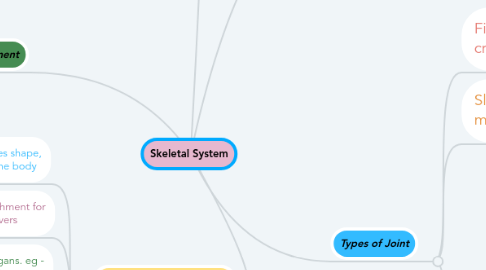
1. Structure of the Skeleton
1.1. Axial - the centre part to the skeleton e.g - cranium, ribs vertabral column
1.2. Appendicular - the attatchments of the skeleton eg - arms, legs. these allow movement
2. Functions of the skeleton
2.1. Support and Shape - gives shape, support and posture to the body
2.2. Movement - provides attachment for muscles and a system of levers
2.3. Protect - protects your vital organs. eg - brain is protected by the Cranium
2.4. Produce - bone marrow produces white blood cell and red blood cells.
2.5. Store - example calcium for healthy strong bones and teeth. Iron is found in your haemoglobin in the red blood cells and transports oxygen to your muscles.
3. Ranges of movement
3.1. Flexion - when the angle between the bones is decreased
3.2. extension - when the angle between the bone is increased
3.3. Abduction - movement away from the midline of the body or other body part.
3.4. adduction - movement towards the midline of the body or body part
3.5. rotation - wherre the bone turns about its longitude axis within the joint
3.6. circumduction - combination of flexion, extension, adduction, abduction and rotation. true circumduction can only take place at all and socket joints
4. Types of Joint
4.1. Fixed - allows movement eg. cranium
4.2. Slightly moveable - allows some movement eg: vertebral column
4.3. Freely moveable (synovial)- allows a free range of movement eg: knee, elbow.
4.3.1. Types Of Synovial Joints
4.3.2. Hinge Joint - movement in one plane only, allowing flexion and extension
4.3.3. Pivot joint - allows rotation and is uniaxial.
4.3.4. Ball and socket joint - allows flexion, extension, rotation, abduction, adduction (all of these at once is circumduction)
4.3.5. Saddle Joint - when a concave surface meets a convex surface, it is bioaxial.
4.3.6. Gliding Joint - allows two flat surfaces to glide over each other and is bioaxial
5. What makes up a joint?
5.1. Cartilage - soft connective tissue, reduces friction and acts as a shock absorber
5.1.1. Yellow Elastic Carlilage - flexible tissue in the ear lobe.
5.1.2. Hyaline/ blue articular carlilage - found on end surfaces of bones , provides a lubricant function, thickens as a result of exercise found in the knee.
5.1.3. White Fibro Cartilage - a tough tissue acts as a shock absorber and is found in the knee and between vertabrae.
